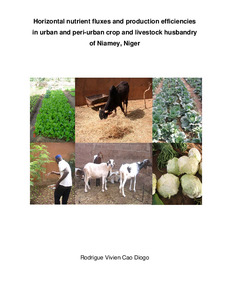| dcterms.abstract | Urban and peri-urban agriculture (UPA) increasingly supplies food and non-food values to the rapidly growing West African cities. However, little is known about the resource use efficiencies in West African small-scale UPA crop and livestock production systems, and about the benefits that urban producers and retailers obtain from the cultivation and sale of UPA products. To contribute to filling this gap of knowledge, the studies comprising this doctoral thesis determined nutrient use efficiencies in representative urban crop and livestock production system in Niamey, Niger, and investigated potential health risks for consumers. Also assessed was the economic efficiency of urban farming activities.
The field study, which was conducted during November 2005 to January 2008, quantified management-related horizontal nutrient flows in 10 vegetable gardens, 9 millet fields and 13 cattle and small ruminant production units. These farms, selected on the basis of a preceding study, represented the diversity of UPA crop and livestock production systems in Niamey. Based on the management intensity, the market orientation and especially the nutrient input to individual gardens and fields, these were categorized as high or low input systems.
In the livestock study, high and low input cattle and small ruminant units were differentiated based on the amounts of total feed dry matter offered daily to the animals at the homestead. Additionally, economic returns to gardeners and market retailers cultivating and selling amaranth, lettuce, cabbage and tomato - four highly appreciated vegetables in Niamey were determined during a 6-months survey in forty gardens and five markets.
For vegetable gardens and millet fields, significant differences in partial horizontal nutrient balances were determined for both management intensities. Per hectare, average annual partial balances for carbon (C), nitrogen (N), phosphorus (P) and potassium (K) amounted to 9936 kg C, 1133 kg N, 223 kg P and 312 kg K in high input vegetable gardens as opposed to 9580 kg C, 290 kg N, 125 kg P and 351 kg K in low input gardens. These surpluses were mainly explained by heavy use of mineral fertilizers and animal manure to which irrigation with nutrient rich wastewater added. In high input millet fields, annual surpluses of 259 kg C ha-1, 126 kg N ha-1, 20 kg P ha-1 and 0.4 kg K ha-1 were determined. Surpluses of 12 kg C ha-1, 17 kg N ha-1, and deficits of -3 kg P ha-1 and -3 kg K ha-1 were determined for low input millet fields. Here, carbon and nutrient inputs predominantly originated from livestock manure application through corralling of sheep, goats and cattle.
In the livestock enterprises, N, P and K supplied by forages offered at the farm exceeded the animals’ requirements for maintenance and growth in high and low input sheep/goat as well as cattle units. The highest average growth rate determined in high input sheep/goat units was 104 g d-1 during the cool dry season, while a maximum average gain of 70 g d-1 was determined for low input sheep/goat units during the hot dry season. In low as well as in high input cattle units, animals lost weight during the hot dry season, and gained weight during the cool dry season. In all livestock units, conversion efficiencies for feeds offered at the homestead were rather poor, ranging from 13 to 42 kg dry matter (DM) per kg live weight gain (LWG) in cattle and from 16 to 43 kg DM kg-1 LWG in sheep/goats, pointing to a substantial waste of feeds and nutrients.
The economic assessment of the production of four high value vegetables pointed to a low efficiency of N and P use in amaranth and lettuce production, causing low economic returns for these crops compared to tomato and cabbage to which inexpensive animal manure was applied. The net profit of market retailers depended on the type of vegetable marketed. In addition it depended on marketplace for amaranth and lettuce, and on season and marketplace for cabbage and tomato.
Analysis of faecal pathogens in lettuce irrigated with river water and fertilized with animal manure indicated a substantial contamination by Salmonella spp. with 7.2 x 104 colony forming units (CFU) per 25 g of produce fresh matter, while counts of Escherichia coli averaged 3.9 x 104 CFU g-1. In lettuce irrigated with wastewater, Salmonella counts averaged 9.8 x 104 CFU 25 g-1 and E. coli counts were 0.6 x 104 CFU g-1; these values exceeded the tolerable contamination levels in vegetables of 10 CFU g-1 for E. coli and of 0 CFU 25 g-1 for Salmonella.
Taken together, the results of this study indicate that Niamey’s UPA enterprises put environmental safety at risk since excess inputs of N, P and K to crop and livestock production units favour N volatilisation and groundwater pollution by nutrient leaching. However, more detailed studies are needed to corroborate these indications. Farmers’ revenues could be significantly increased if nutrient use efficiency in the different production (sub)systems was improved by better matching nutrient supply through fertilizers and feeds with the actual nutrient demands of plants and animals. | eng |

